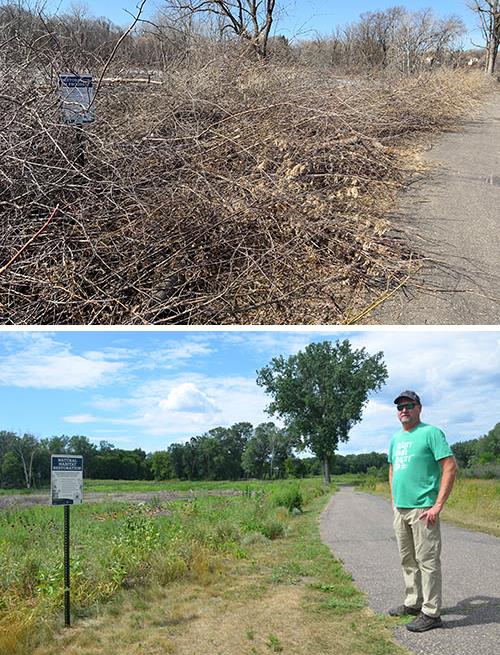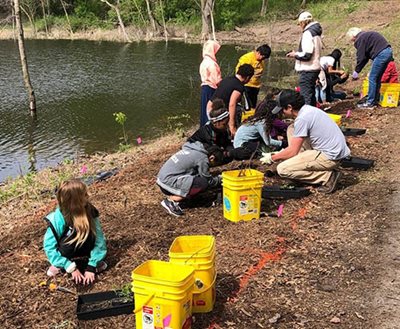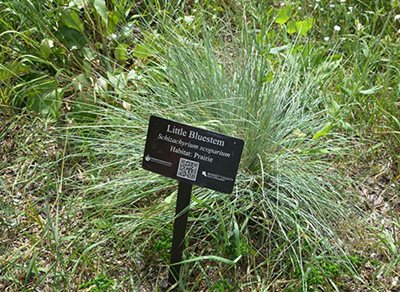 Longtime visitors to the Snail and Grass lakes section of Vadnais-Snail Lakes Regional Park in northern Ramsey County have witnessed a dramatic change in the last three years.
Longtime visitors to the Snail and Grass lakes section of Vadnais-Snail Lakes Regional Park in northern Ramsey County have witnessed a dramatic change in the last three years.
Where dense stands of invasive buckthorn trees blocked views of a large wetland, more than 100 species of native perennial wildflowers and grasses now thrive on the sloping shoreland. Scores of trees that died due to persistent flooding of the wetland basin have been cleared. Some portions of walking trails have been repaved and plans are in the works for a possible boardwalk on the east side of the wetland.
“The shore area was basically impenetrable,” said Bill Bartodziej, natural resources specialist for the Ramsey-Washington Watershed District. “We did a massive removal of buckthorn and the invasive groundcover species that had grown below the buckthorn.
“Over the last three years we had hundreds of volunteers out here, many of them schoolchildren, planting native species,” he said. “A total of 1.25 miles of wetland shore and 7.6 acres of buffer have been restored.”
Restoring native habitat at the wetland has many benefits, not the least of which is protecting water quality and building in resilience to climate change impacts. As flooding of the closed wetland basin increases with more intense rain events – and then draws down with periods of prolonged drought – soil erosion can be a big problem. But the diverse plant community keeps the soil in place and thrives through the different conditions.

Restoring the adjacent oak woodlands
At the same time, Ramsey County Parks and Recreation staff have been working to restore the oak-dominated woodlands to the west and south of the wetland. This, too, has involved removal of buckthorn and invasive groundcover species, and adding seeds of species native to oak woodland habitat.
“Our long-term goal is to get native shrubs, grasses, and wildflowers underneath the tree canopy once again,” said Mike Goodnature, natural resource manager for Ramsey County Parks. “It has been amazing to see the little oak seedlings pop up after sitting dormant for years underneath the dense buckthorn.”
Funding for the joint restoration project came from the Outdoor Heritage Conservation Partners Legacy Grant Program, the watershed district, and Ramsey County.
Addressing flooding in the larger park area
Vadnais-Snail Lakes Regional Park has been the focus of attention from multiple agencies for more than a decade. The park and surrounding area have seen above-normal precipitation and groundwater levels that have led to flooding of roads, trails, and park picnic areas. In addition to the watershed district and the parks department, the City of Shoreview, the Minnesota Department of Natural Resources, the Vadnais Lakes Water Management Organization, and the Metropolitan Council have all been involved in discussing flood water storage options and drainage improvements in and around the regional park.
 In 2021, Ramsey County Parks submitted a master plan amendment for the park to the Met Council that it characterized as a “climate change resilience project to address flooding concerns.”
In 2021, Ramsey County Parks submitted a master plan amendment for the park to the Met Council that it characterized as a “climate change resilience project to address flooding concerns.”
The plan includes replacement of park infrastructure on both Snail and Grass lakes, including trails, picnic facilities, and parking, due to high water. Parks planners are exploring the possibility of creating a boardwalk for a portion of the trail system both around the wetland and on the south side of Grass Lake. A trail feasibility study, currently under way, is exploring what trail types will be allowed under local, state, and federal requirements, given that the wetland area trail is located within a floodplain.
“The challenge and the purpose of the feasibility study is to redesign infrastructure amenities like the beach and trails to accommodate both high and low water levels, which can fluctuate by six feet in certain areas of the park,” said Brett Blumer, landscape architect with Ramsey County Parks.

Relocation of a sewer interceptor
In response to the persistent flooding, the Met Council’s Environmental Services division is planning to relocate a large sewer interceptor that runs north from I-694 to the east of Grass Lake to Gramsie Road, inside the regional park.
Where the pipe was once 30 feet from the shore of Grass Lake and accessible via several maintenance structures, some of those are now under 1 to 5 feet of water, explained Mike Villari, Environmental Services engineer. Without being able to access the pipe, debris can accumulate and cause wastewater backups.
The Met Council has been working closely with Ramsey County on the project, because both the pipe and an existing hiking trail will be relocated much closer to the existing Soo Line Railroad track that runs between Grass Lake and Rice Street. The paved trail will allow for access to the interceptor sewer. Construction is expected to begin in 2023.
 An outdoor learning laboratory
An outdoor learning laboratory
Back at the wetland, birdwatchers have recently seen a red-headed woodpecker, a species that has declined precipitously in the metro area in the last several decades. Dozens of herons, egrets, and even a pair of sandhill cranes can often be seen at the wetland.
While large mammals can thrive in many landscapes, birds and insects really take a hit when invasive plant species take over, Goodnature said. “Those species have been declining in vast numbers, and they benefit from these restoration efforts.”
Visitors who want to learn more about the amazing variety of plant species along the shoreline now need only pull out their smart phones. Signs among the plants identify the names and have a QR code that connects to iNaturalist, a website that delivers more information about the plants.
Learn more about the wetland restoration project
Visiting Vadnais-Snail Lakes Regional Park